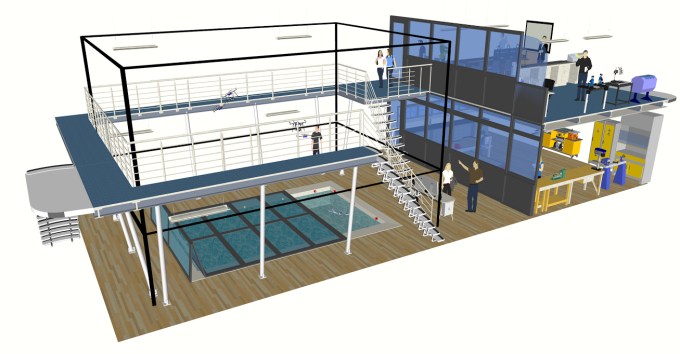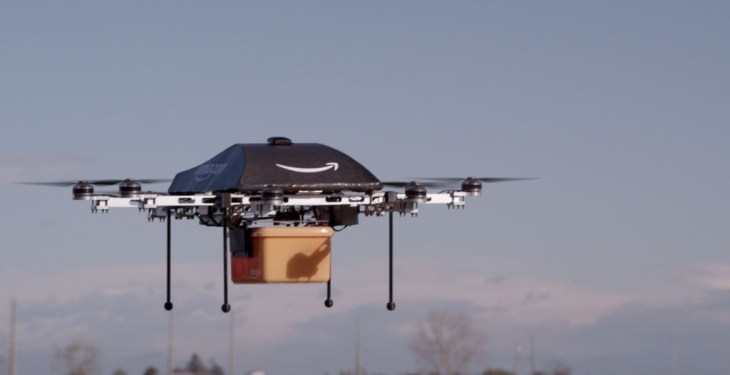Amazon and Google might be chest-thumping about their respective drone delivery programs but the technology is still years out from being feasible in dense urban environments. Dr Mirko Kovac, director of Imperial College London‘s current aerial robotics lab, suggests it could be as far out as a decade.
“Drone delivery in cities is still something that it’s not sure how feasible it is in a big city like London for example,” he said in an interview with TechCrunch, noting that safety remains the key challenge for Amazon et al operating drones in urban areas.
“Flying close to humans, flying close to buildings, flying close to other flying vehicles, and legislation, insurance, air traffic control, all this needs to be sorted before something like this can be demonstrated,” he added. “So central London might not be the best first step… It’s difficult to put a number on it but maybe in a decade we will have commercial drone delivery in cities. That’s maybe reasonable.”
Kovac added that drone delivery will likely arrive sooner in other types of environments — principally where there’s more room for manoeuvre and fewer obstacles for drones to worry about. “Drone delivery in other areas such as in developing countries, such as Africa or Asia for example, there I think it’s much closer because there there is vast spaces and it could be much more feasible to test and implement something there.”
Nearer-term commercial applications for drones will focus on rather more mundane tasks — at least from a consumer’s eye view — such as inspection and repair of structures, he added.
“That is much more close,” said Kovac. “Already you can do 3D mapping of the environment [with drones], with something that is already on the market now — but the next step is the interaction with an environment. So anything that interacts with an environment, like sampling and flight in more constrained environments, like indoors, inside of mines, for examples, making 3D map of the mine structure, or making 3D map of buildings in different ways for the construction industry. These areas are much more close.”
Imperial’s incoming drone research lab
Earlier this month Imperial announced it will be building a shiny new drones research facility — due to open in 2017. Costing £1.25 million to build, the glassy structure will sit atop an existing building on its South Kensington campus so that students and others can peer up at drones being put through their paces and be inspired by the potential of the tech and the research being conducted. The drone lab’s visibility is absolutely intentional, says Kovac.
“The flight lab will be a very good nurturing ground for actually developing the flying robots. We do that already but it will leverage the capabilities we have already now. What it will be also providing us with is a very high exposure — so it will be a very visible VIP type facility that will be very visible and good for visitors and also to see how the research is done.”

Image credit: Imperial College London and Rob Sidall
The facility will include a glass-walled flight arena for testing drones in the air, a pool where amphibious drones can take a dip, 3D printing facilities to produce rapid prototypes, and an outdoor platform where prototype drones can take to the skies. There will also be 16 high speed cameras in the facility to enable 3D tracking of the drones in flight.
“It’s a new space that is tailored even more to this type of research,” added Kovac, explaining what’s new with the incoming lab vs the university’s current drone research facilities.
Imperial is not the only university to zero in on drones. There are dedicated drone research facilities at several others, including MIT, Harvard and UZH in Zurich, but Kovac said the Imperial lab will offer something different. Specifically hybrid drone research.
“What’s novel about ours is it allows us to work on hybrids — so multimodal mobilities. So robots that can move in air, on ground, in water, in complex environments, in forests. This is something we are focusing on,” he told TechCrunch. “It’s the next step for flying robots.”
A hybrid teaching and research model is also part of the plan, with “integrated teaching and research” planned — so “you can actually educate the next generation of aeronautics engineers that we know how to operate and have the skillset to work in this unmanned aerial vehicles space”.
Given his long view on drone delivery, it’s no surprise that Imperial’s lab will be focusing its research on other areas. Specifically the aforementioned “aerial construction” inspection and repair tasks, and also on environmental monitoring use-cases such as pollution tracking.
“Currently often samples are taken manually with people in the rainforest or in the sea or on ground so this can be automated,” said Kovac. “This is something we are working on — how to do that in an automated way using swarms of flying robots. This should then make it much cheaper for the operators or the industry to do, and it’s a very convenient and safe and quick way to do it.”
Power and battery life remain key challenges for improving the performance of aerial robotics so the lab will also be researching new concepts for propulsion systems, energy storage, low power computation and high efficiency flight.
“There are developments in fuel cells and different types of battery technology that have huge potential. The approach we take is that we optimize the aerodynamics of the platform so we use less energy for flight and like this we increase the range and flight direction,” he added. “It’s an alternative approach. We don’t work on battery technology ourself.”
Drone flight inspired by nature
It will look at ways to improve drone aerodynamics by studying biology — so looking to flying creatures such as birds and insects for inspiration. “We can look at how nature solves some of those challenges. We can look at flying animals, birds, insects, and we can extract the key design principles that they use and apply them to robots to make much better drones,” added Kovac.
“We’ve done this successfully in the past and I think this is one of the main pathways — how we’re going to make new flying robots very good.”
Kovac said Imperial is looking for commercial partners for the lab as a way to accelerate marketplace applications of the research — and is “open for collaboration”, as he put it. The facility is also taking in funding from research councils, and applying for grants — with Kovac noting the U.K. government is recognizing drone tech as “an important area to invest in”.
“We have a lot of interest from industry. How we do that is we use the London Robotics Network. It is a network that I co-founded with an industrial partner — which is Shadow Robotics — and Kings College London. We came up with this idea to create a network where these kind of collaborations and synergies can be built and executed,” he added. “We are now really looking for ways how to bring this technology to the market together with industrial partners.”
Kovac said Amazon could “potentially” be one such partner — given the company is ramping up its Prime Air drone delivery program in Cambridge — but added that he has not personally worked with them.
“Drones are still very much perceived as being a military technology and only now they start to move into the civil space. And there many big companies are now really interested in that and they’re investing and exploring, prototyping, starting to adopt the technology slowly. But this is really just happening now. It’s not something that is very established already. The potential is now really being only discovered,” he added.
